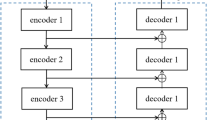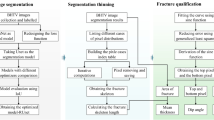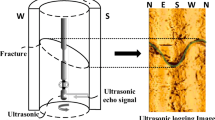Abstract
Accurate recognition of rock fractures is an important problem in rock engineering because fractures greatly influence the mechanical and hydraulic properties of rock structures. However, existing image segmentation methods for identifying rock fractures tend to be limited to handling only very simple fracture images, despite many real cases containing interfering objects or features such as dark surfaces, stripes (e.g., from foliation), infilling materials, scratches, shadows, and vegetation. Here, we propose a novel deep convolutional neural network to construct the first model that is applicable in the field. After selecting U-Net, a simple and powerful network for semantic segmentation, as a baseline network, we tested network architectures by applying atrous convolutions and extra skip connections to develop an optimal network specialized for rock fracture segmentation. The rate of erroneously detecting non-fracture objects or features was reduced by using the atrous convolution module, and more skip connections were appropriately added to increase the detection rate of the actual fractures. The model's performance gradually improved as these new techniques were added to the original model. Contrast-limited adaptive histogram equalization and a fully connected conditional random field were applied before and after the network, respectively, to enhance the model’s performance. Evaluation of the proposed model using raw images of diverse site conditions shows that it can effectively distinguish rock fractures from various interfering objects and features. The source code and pre-trained model can be freely download from GitHub repository (https://github.com/Montherapy/Rock-fracture-segmentation-with-Tensorflow).









Similar content being viewed by others
References
Alqahtani N, Armstrong RT, Mostaghimi P (2018) Deep learning convolutional neural networks to predict porous media properties. Society of Petroleum Engineers, In SPE Asia Pacific oil and gas conference and exhibition
Badrinarayanan V, Kendall A, Cipolla R (2017) Segnet: A deep convolutional encoder-decoder architecture for image segmentation. IEEE Trans Pattern Anal Mach Intell 39(12):2481–2495
Chen LC, Papandreou G, Kokkinos I, Murphy K, Yuille AL (2017) Deeplab: Semantic image segmentation with deep convolutional nets, atrous convolution, and fully connected crfs. IEEE Trans Pattern Anal Mach Intell 40(4):834–848
Chen LC, Zhu Y, Papandreou G, Schroff F, Adam H (2018) Encoder-decoder with atrous separable convolution for semantic image segmentation. In: Proceedings of the European conference on computer vision, ECCV, pp 801–818
Cheng G, Guo W (2017) Rock images classification by using deep convolution neural network. IOP Conference Series: J Phys 887:012089
Chollet F (2017) Xception: Deep learning with depthwise separable convolutions. In: Proceedings of the IEEE conference on computer vision and pattern recognition, CVPR, pp 1251–1258
Dias LO, Bom CR, Faria EL, Valentín MB, Correia MD, Márcio P, Marcelo P, Coelho JM (2020) Automatic detection of fractures and breakouts patterns in acoustic borehole image logs using fast-region convolutional neural networks. J Petrol Sci Eng 191:107099
Dumoulin V, Visin F (2016) A guide to convolution arithmetic for deep learning. arXiv. https://arxiv.org/abs/1603.07285
Ferreira A, Giraldi G (2017) Convolutional Neural Network approaches to granite tiles classification. Expert Syst Appl 84:1–11
Gonzalez RC, Woods RE (2002) Digital image processing, 2nd edn. Prentice Hall, New Jersey
He K, Zhang X, Ren S, Sun J (2015a) Spatial pyramid pooling in deep convolutional networks for visual recognition. IEEE Trans Pattern Anal Mach Intell 37(9):1904–1916
He K, Zhang X, Ren S, Sun J (2015b) Delving deep into rectifiers: Surpassing human-level performance on imagenet classification. In: Proceedings of the IEEE international conference on computer vision, ICCV, pp 1026–1034
He K, Zhang X, Ren S, Sun J (2016) Deep residual learning for image recognition. In: Proceedings of the IEEE conference on computer vision and pattern recognition, CVPR, pp 770–778
He M, Zhang Z, Ren J, Huan J, Li G, Chen Y, Li, (2019) Deep convolutional neural network for fast determination of the rock strength parameters using drilling data. Int J Rock Mech Min Sci 123:104084
Hu J, Shen L, Sun G (2018) Squeeze-and-excitation networks. In: Proceedings of the IEEE conference on computer vision and pattern recognition, CVPR, pp 7132–7141
Huang G, Liu Z, Van Der Maaten L, Weinberger KQ (2017) Densely connected convolutional networks. In: Proceedings of the IEEE conference on computer vision and pattern recognition, CVPR, pp 4700–4708
Hummel R (1977) Image enhancement by histogram transformation. Comp Graph Image Process 6:184–195
Iandola FN, Han S, Moskewicz MW, Ashraf K, Dally WJ, Keutzer K (2016) SqueezeNet: AlexNet-level accuracy with 50x fewer parameters and< 0.5 MB model size. arXiv. https://arxiv.org/abs/1602.07360
Ioffe S, Szegedy C (2015) Batch normalization: Accelerating deep network training by reducing internal covariate shift. arXiv. https://arxiv.org/abs/1502.03167
Kamrava S, Tahmasebi P, Sahimi M (2019) Enhancing images of shale formations by a hybrid stochastic and deep learning algorithm. Neural Netw 118:310–320
Karimpouli S, Tahmasebi P (2019a) Image-based velocity estimation of rock using Convolutional Neural Networks. Neural Netw 111:89–97
Karimpouli S, Tahmasebi P (2019b) Segmentation of digital rock images using deep convolutional autoencoder networks. Comput Geosci 126:142–150
Karimpouli S, Tahmasebi P, Saenger EH (2020) Coal cleat/fracture segmentation using convolutional neural networks. Nat Resour Res 29(3):1675–1685
Kingma DP, Ba J (2014) Adam: A method for stochastic optimization. arXiv. https://arxiv.org/abs/1412.6980
Krähenbühl P, Koltun V (2011) Efficient inference in fully connected crfs with gaussian edge potentials. In: Advances in neural information processing systems, NIPS, pp 109–117
Krizhevsky A, Sutskever I, Hinton GE (2012) Imagenet classification with deep convolutional neural networks. In: Advances in neural information processing systems, NIPS, pp 1097–1105
Lemy F, Hadjigeorgiou J (2003) Discontinuity trace map construction using photographs of rock exposures. Int J Rock Mech Min Sci 40(6):903–917
Li H, Qian X, Li W (2016) Image semantic segmentation based on fully convolutional neural network and CRF. In: International conference on geo-informatics in resource management and sustainable ecosystem, GRMSE, pp 245–250
Liang Y (2016) Rock fracture skeleton tracing by image processing and quantitative analysis by geometry features. J Geophys Eng 13(3):273–284
Lin G, Milan A, Shen C, Reid I (2017) Refinenet: Multi-path refinement networks for high-resolution semantic segmentation. In: Proceedings of the IEEE conference on computer vision and pattern recognition, CVPR, pp 1925–1934
Liu W, Rabinovich A, Berg AC (2015) Parsenet: Looking wider to see better. arXiv. https://arxiv.org/abs/1506.04579
Long J, Shelhamer E, Darrell T (2015) Fully convolutional networks for semantic segmentation. In: Proceedings of the IEEE conference on computer vision and pattern recognition, CVPR, pp 3431–3440
Lu F, Fu C, Zhang G, Zhang W, Xie Y, Li Z (2020) Convolution neural network based on fusion parallel multiscale features for segmenting fractures in coal-rock images. J Electron 29(2):023008
McCarter MK (1976) Application of plane photogrammetry to open pit mapping. Snowbird, Society of Mining Engineers of AIME, US Symposium on Rock mechanics, pp 93–98
Mohebbi M, Yarahmadi Bafghi AR, Fatehi Marji M, Gholamnejad J (2017) Rock mass structural data analysis using image processing techniques (Case study: Choghart iron ore mine northern slopes). J Min Environ 8(1):61–74
Nair V, Hinton, GE (2010) Rectified linear units improve restricted boltzmann machines. In: Proceedings of the 27th international conference on machine learning, ICML, pp 807–814
Nishad PM (2013) Various colour spaces and colour space conversion. J Glob Res Comput Sci 4(1):44–48
Pascanu R, Mikolov T, Bengio Y (2013) On the difficulty of training recurrent neural networks. In: International conference on machine learning, ICML, pp 1310–1318
Pizer SM, Amburn EP, Austin JD, Cromartie R, Geselowitz A, Greer T, Romeny B, Zimmerman J, Zuiderveld K (1987) Adaptive histogram equalization and its variations. Comput vis Graph Image Process 39(3):355–368
Reid TR, Harrison JP (2000) A semi-automated methodology for discontinuity trace detection in digital images of rock mass exposures. Int J Rock Mech Min Sci 37(7):1073–1089
Ronneberger O, Fischer P, Brox T (2015) U-net: Convolutional networks for biomedical image segmentation. In: International conference on medical image computing and computer-assisted intervention, MICCAI, pp 234–241
Russakovsky O, Deng J, Su H, Krause J, Satheesh S, Ma S, Huang Z, Karpathy A, Khosla A, Bernstein M, Berg AC, Fei-Fei L (2015) Imagenet large scale visual recognition challenge. Int J Comput vis 115(3):211–252
Simonyan K, Zisserman A (2014) Very deep convolutional networks for large-scale image recognition. arXiv. https://arxiv.org/abs/1409.1556
Srivastava RK, Greff K, Schmidhuber J (2015) Highway networks. arXiv. https://arxiv.org/abs/1505.00387
Szegedy C, Liu W, Jia Y, Sermanet P, Reed S, Anguelov D, Erhan D, Vanhoucke V, Rabinovich A (2015) Going deeper with convolutions. In: Proceedings of the IEEE conference on computer vision and pattern recognition, CVPR, pp 1–9
Tong T, Li G, Liu X, Gao Q (2017) Image super-resolution using dense skip connections. In: Proceedings of the IEEE international conference on computer vision, ICCV, pp 4799–4807
Valentín MB, Bom CR, Coelho JM, Correia MD, Márcio P, Marcelo P, Faria EL (2019) A deep residual convolutional neural network for automatic lithological facies identification in Brazilian pre-salt oilfield wellbore image logs. J Petrol Sci Eng 179:474–503
Valsecchi A, Damas S, Tubilleja C, Arechalde J (2020) Stochastic reconstruction of 3D porous media from 2D images using generative adversarial networks. Neurocomputing 399:227–236
Wada K (2016) labelme: image polygonal annotation with python, GitHub repository. https://github.com/wkentaro/labelme. Accessed 9 May 2019
Wang W (2005) An edge based segmentation algorithm for rock fracture tracing. In: International conference on computer graphics, imaging and visualization, CGIV, pp 43–48
Wang WX, Li WS, Yu X (2012) Fractional differential algorithms for rock fracture images. Imaging Sci J 60(2):103–111
Wang W, Liao H, Huang Y (2007) Rock fracture tracing based on image processing and SVM. In: Third international conference on natural computation, ICNC, pp 632–635
Xia X, Kulis B (2017) W-net: A deep model for fully unsupervised image segmentation. arXiv. https://arxiv.org/abs/1711.08506
Xie S, Girshick R, Dollár P, Tu Z, He K (2017) Aggregated residual transformations for deep neural networks. In: Proceedings of the IEEE conference on computer vision and pattern recognition, CVPR, pp 1492–1500
Xie S, Tu Z (2015) Holistically-nested edge detection. In: Proceedings of the IEEE international conference on computer vision, ICCV, pp 1395–1403
Yu F, Koltun V (2015) Multi-scale context aggregation by dilated convolutions. arXiv. https://arxiv.org/abs/1511.07122
Zhang W, Wu T, Li Z, Liu S, Qiu A, Li Y, Shi Y (2021) Fracture recognition in ultrasonic logging images via unsupervised segmentation network. Earth Sci Inform 14(2):955–964
Acknowledgements
This work was supported by a National Research Foundation of Korea (NRF) grant funded by the Korean government (MSIT) (No. NRF-2019R1F1A1060064), and also supported by a grant from the Human Resources Development program of the Korea Institute of Energy Technology Evaluation and Planning (KETEP), funded by the Ministry of Trade, Industry, and Energy of the Korean Government (No.20204010600250).
Author information
Authors and Affiliations
Corresponding author
Additional information
Communicated by H. Babaie.
Publisher’s note
Springer Nature remains neutral with regard to jurisdictional claims in published maps and institutional affiliations.
Rights and permissions
About this article
Cite this article
Byun, H., Kim, J., Yoon, D. et al. A deep convolutional neural network for rock fracture image segmentation. Earth Sci Inform 14, 1937–1951 (2021). https://doi.org/10.1007/s12145-021-00650-1
Received:
Accepted:
Published:
Issue Date:
DOI: https://doi.org/10.1007/s12145-021-00650-1




